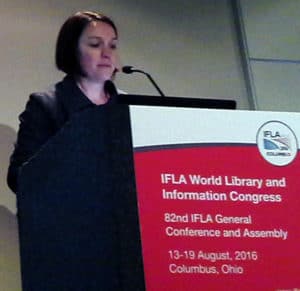Inclusive School Libraries
IFLA session explores tactics for accessibility and advocacy

Top row (left to right): Lesley Farmer, Gertrude C. Umunnakwe, Emmanuel U. Anyanwu, Valérie Glass, Isabel Mendinhos. Seated (left to right): Clayton Copeland, Karen Gavigan, and Elizabeth Burns.
What’s the best way to provide resources, instruction, and librarianship to both typically and differently able students?
At “Inclusionary Practices to Support School Libraries,” a Thursday morning session at the International Federation of Library Associations and Institutions (IFLA) World Library and Information Congress, librarians from Nigeria, France, Portugal, and the United States attempted to answer this question by examining inclusionary and accessibility strategies in school libraries.
Clayton Copeland and Karen Gavigan, both instructors at the University of South Carolina School of Library and Information Science, shared findings from a middle-school classroom they observed in a rural, low-income area of the southeastern US. They spoke of Miss Sally, the librarian who cultivated a love for library time among her typically and differently able students.
“It is a well-tooled librarian who is able to create an inclusive and accessible environment,” Copeland said. “Individualize, don’t generalize,” was Copeland’s advice for inclusivity.
Copeland and Gavigan say that Miss Sally’s differently able students began to feel safe and equal in the setting she created, and her typically able students began to form relationships with them outside of the library, on field trips and at school sporting events.
Copeland and Gavigan noted that one challenge to creating such an environment is a hesitation and fear among librarians about knowing what “developmentally appropriate teaching strategies” are for students.

Valérie Glass, of the Association des Professeurs Documentalistes de l’Éducation Nationale in Paris, also studied how programs and activities in schools can reach students of different abilities and backgrounds. “There’s an inclusive dimension enshrined in most French educational acts,” said Glass.
Her research found that key to creating an inclusive environment is adopting a wide range of resources and library materials for different abilities. Glass suggested video games, manga, and magazines as items to attract differently able students.
She also emphasized the importance of tailored support and multidisciplinary work to reach all types of learners. An example of this is a web radio class where “each student can have a role” in producing the show, Glass said.
Isabel Mendinhos, of the School Library Network in Lisbon, Portugal, found out that very little was being done in her country with regard to special needs educational services. Her Inclusive School Libraries | American Libraries Magazine:
